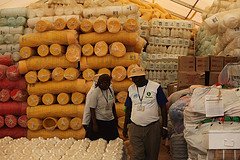The Guardian newspaper is tracking donations to famine relief in East Africa. They’re updating their figures every Monday, based on the UN OCHA numbers as they come in. I took a look to see what countries are giving, and how much.
The United States is giving about half a billion dollars, more than any other country. $534,821,220, to be precise. It’s a respectable amount in the light of everything going on in the US economy. Most of that money is going to Ethiopia and Kenya. Kenya, I assume, for famine refugees, and Ethiopia for its own food crisis. Only $77 million is going to the Somalia combined appeal. Saudi Arabia has different priorities – almost opposite. It has pledged $50 million to Somalia, and $744,137 to Kenya.
The Russian Federation has promised a paltry $1 million, all to Kenya. It’s hard to see such a small amount as anything beyond a gesture to show they’re still a donor country and not just a recipient. Interestingly, Russia has been out-donored by Sudan, which has pledged $2.5 million to Ethiopian famine response.
In terms of nontraditional donors – Brazil has pledged $27,477,513. China so far has offered nothing. It’s possible – and we can hope – that China is providing aid that’s not being tracked by the OCHA data that The Guardian is using.
Overall, these numbers are still less than half of what is needed for an effective famine response. There is over a billion dollars in unmet need. That is an awful lot of lives being lost.
We could all learn a lesson from Kenya. Kenyan private donors have now pledged over four million dollars to famine response. That’s more money than has been pledged by Italy or Ireland. Kenya’s population is 40 million people. Kenya’s per capita GDP is $1600 – that means private donations have reached 2500 times the Kenyan per capita GDP. If the US gave at the same rate we’d be giving 120 billion dollars for famine relief. If Americans were as generous as Kenyans, we could fund every open OCHA appeal fully, three times over.
